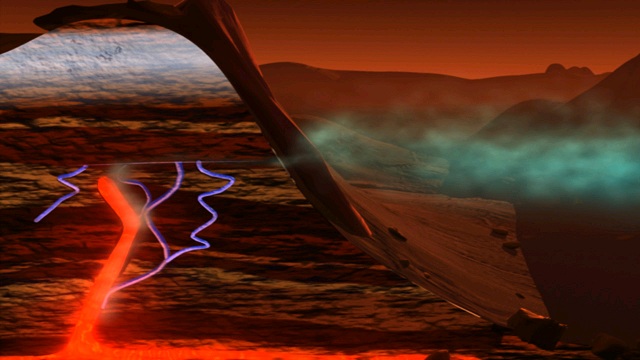In the first measurements of the European Mars Express spacecraft orbiting Mars, methane was discovered in the planet's atmosphere. This discovery was surprising

In the first measurements of the European Mars Express spacecraft orbiting Mars, methane was discovered in the planet's atmosphere. This discovery was surprising since they did not expect to find it at all. On Earth, the source of methane is biological, although it can also be a product of volcanic activity. Supporting evidence for this discovery comes from two spectroscopic observations from Earth directed toward Mars, observations each made independently (1). This discovery raised hope among researchers that it might finally be possible to discover signs of life on Mars.
Most of the methane on Earth is organic. It originates from the Methanogen Archaea microbe. These are methane producing life forms. They absorb hydrogen and CO2 and emit methane. The methanogens are found in closed places like the intestines of cows. Other sources are reactions between water and hot rocks that contain carbon or in the natural breakdown of carbon and oil (2). On Earth, methane is also found in the rock found 200 meters below the ground, life was found in the form of the methanogens. It turned out that these creatures are also found deep in the ice of Antarctica and they emit methane in an amount that affects the concentration of the gas found in various wells. In methane pockets in ice blocks drilled in Greenland CO2 a methane concentration 10 times higher than expected was found (3). Another option for creating methane is the following: water containing comes in contact with olivine (a mineral) creating hydrogen that can come in contact with CO2 and the final product is methane (4).
The largest concentrations of methane on Mars coincide with places where there are concentrations of water vapor and underground ice, which could indicate a common source. They try to explain this using the "ice-table" concept. According to this concept, geothermal heat coming from below causes water and other materials to move up towards the surface. On their way up, the water freezes due to the low surface temperature. One of the most intriguing and important questions is, can methane-producing bacteria live in the underground water? (5).
High concentrations of methane were found in 3 places in the Northern Hemisphere - in the Tharsis and Elysium volcanoes and in Arabia Terrae. The highest concentration is found in Tharsis where geological processes including trending, hydrothermal and geothermal activity are still taking place (6).
From a spectroscopic examination of the Martian atmosphere from Earth, it became clear that the concentration of methane in the atmosphere at the equator is 200 parts per million and near the poles 20-60 parts per million. Another spectroscopic test, also from Earth, showed that the global average is 11 parts per million, with a range of 7-15 parts per million (7). The seasonal changes of methane were also examined and it became clear that the highest concentration is in the Northern Hemisphere with local peaks of 70 parts per million. In winter there is a sharp drop in concentration and it reaches the latitudes 50-40°. The concentration begins to rise again in the spring and more rapidly in the summer and it spreads over the entire planet. Very high levels of methane are in the summer of the southern hemisphere. It may be related to the circulation that occurs in the atmosphere, a phenomenon that was confirmed in a computer simulation (6).
The processes that reduce the amount of methane in the atmosphere are not clear. Photochemical processes cannot break down the gas quickly. A possibility that should be taken into account is that strong winds can add strong oxidizers to the atmosphere such as highly reactive perchlorate salts that are able to absorb the methane quickly (6).
According to estimates, methane should disappear from the Martian atmosphere within 300 years. To the researchers' surprise, the methane disappeared completely at the beginning of 2006. It is clear that there was some unusual event that caused this, although it is not known what it was (1).
It may be that the increase in the amount of methane in the hot seasons is due to the fact that during these times of the year, pores or cracks open in the frozen ground and they allow methane to evaporate "and take its place" in the atmosphere (8).
Sources
1."Mars, Methane and mysteries" 11.8.2009
http://www.marsdaily.com/reports/Mars_Methane_ And_ Mysteries_999.html
2. Tenennbaum D. - "Making sense of Mars Methane" 10.6.2008
http://www.marsdaily.com/reports/ Making _Sense _Of _ Mars_ Methane_999.html
3. Britt RA- “Crater critters: Where Mars microbes might be?” 20.12.2005
http://www.spacedaily.com/scienceastronomy/051220-science-html
4. "Methane doesn't necessarily mean life on Mars" 8.6.2005
http://www.spacedaily.com/mars-life–05.mhtml
5. "Water and Methane maps overlap on Mars: A new clue?" 21.9.2004
http://www.spacedaily.com/news/marsexpress-04zc.html
6. "Mars methane lasts less than a year" 23.9.2010
http://www.marsdaily.com/reports/ Mars_ Methane_ Lasts_ Less_ Tthan _A _Year_999.html
7. Tenennbaum D. – “Interplanetary whodunit-Methane on Mars” 21.7.2005
http://www.spacedaily.com/news/ mars-life–05.rhtml
8. "Dead or alive Mars pumps Methane" 16.1.2009
http://www.marsdaily.com/reports/Dead_ Or_ Alive _Mars_ Pumps _Methane_999.html

One response
Is methane not the basis for creating life, or sustaining life?